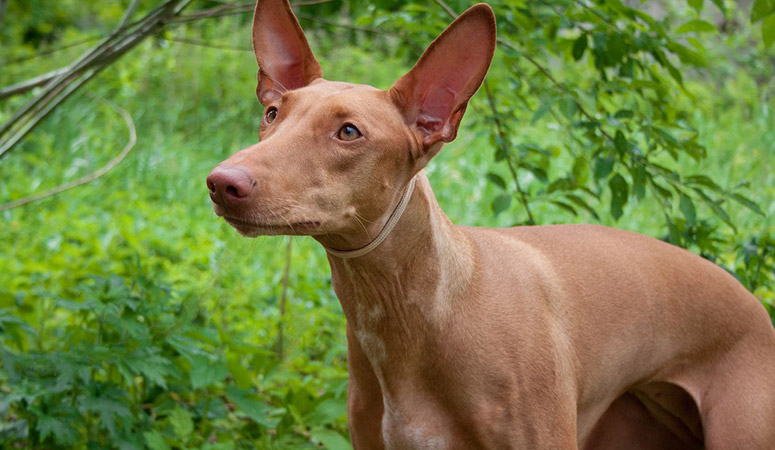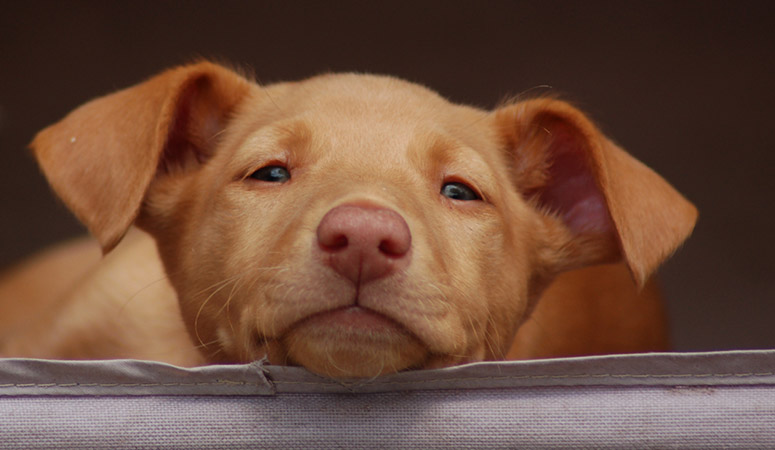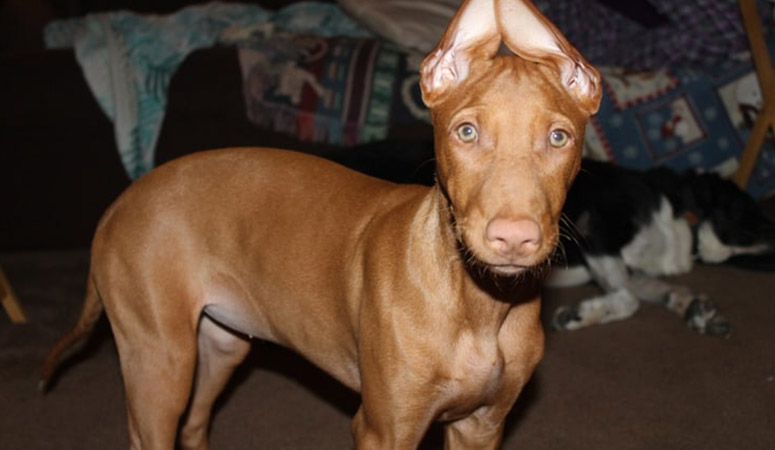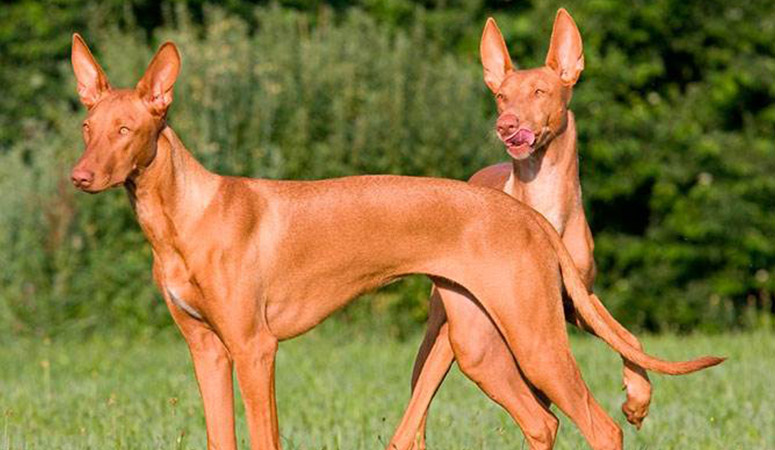Pharaoh Hound
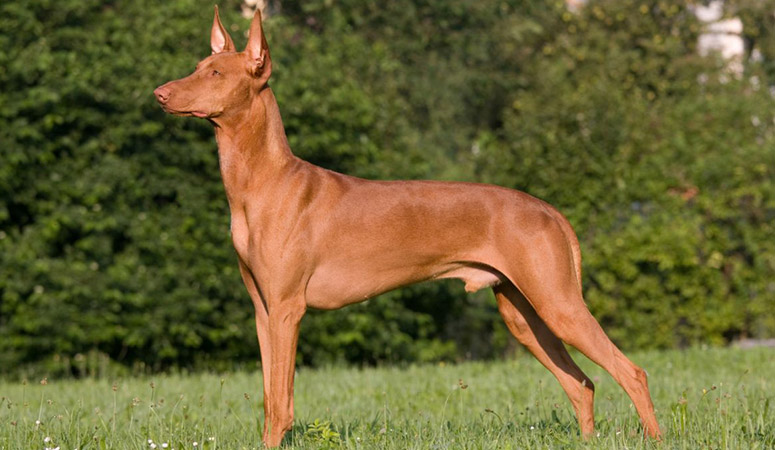
The Pharaoh Hound, ancient “Blushing Dog” of Malta, has hunted by sight and scent, as well as hearing with greyhound-like build. His good nose and large mobile ears can help him follow animals underground. Pharaoh Hounds like to delight their humans with clownish antics and want to make you laugh, which makes him a loyal friend for life.
| Other Names | Kelb Tal-Fenek |
| Color | Chestnut, Red Golden, Rich Tan, Tan |
| Height | Males: 22-25 inches. Females: 21-24 inches. |
| Weight | Males: 45-55 pounds. Females: 45-55 pounds. |
| Life Span | 12-14 years |
| Personality | Friendly, Smart, Noble |
| Exercise | Needs Lots of Activity |
| Origin |
| Popularity | #161 |
| Groom Needs | Weekly Brushing |
| Kids Friendly | Yes with supervision |
| Dog Friendly | Yes |
| Watch Dog | |
| Family Dog | Yes |
| Litter Size | 6-8 puppies |
Pharaoh Hound Pictures
Pharaoh Hound Video
Introduction
The Pharaoh Hound has the build of an elegant and powerful dog. The wedge-shaped head and long, muscular neck are erect when it is alert. Although it doesn’t appear too muscular, the Pharaoh Hound is a strong and athletic breed with the right amount of fervor and bulk to support it. They come in a short coat without feathering. The coat must not become so flurry that it begins to stand away from the skin. The only accepted coat color by most kennel clubs is red, although the shades of red vary widely. White markings on the chest, toes, and few other areas can be tolerated.
A full-grown male stands 23-25 inches from shoulder to paw and weighs close to 55 pounds. A similar female weighs in the range of 45-50 pounds, and measures around 21-24 inches tall. Pharaoh Hounds have an average life expectancy of 11-14 years.
Living with Pharaoh Hound
The Pharaoh Hound Pharaoh hound doesn’t need a lot of grooming. Introduce your Pharaoh Hound to being brushed and examined when he’s a puppy. Make grooming a positive experience filled with praise and rewards, and you’ll lay the groundwork for easy veterinary exams and other handling when he’s an adult.
Weekly brushing with a hound glove and a rubber mitt with a nubby palm that fits over the hand will help remove loose hair and keep it from settling on your clothes and furniture.
Pharaoh Hounds don’t have a strong doggy odor and don’t need frequent baths. Unless he’s been rolling around in something stinky, wiping him down daily with a damp cloth will in most cases keep him clean.
Your Pharaoh Hound’s skin will need some care too. The short coat isn’t very protective, and cuts, scrapes, and other irritations are common. Check your dog for nicks and cuts every time you brush him.
Check his ears weekly for redness or a bad odor, which can indicate an infection. And wipe them out with a cotton ball dampened with gentle, pH-balanced ear cleaner to help prevent infections. Don’t insert anything into the ear canal; just clean the outer ear.
Trim nails once or twice a month to avoid excessive growth, splitting and cracking. Handle his paws frequently — dogs are touchy about their feet — and look inside his mouth.
Brush your Pharaoh Hound’s teeth at least two or three times a week to remove tartar buildup and the bacteria that lurk inside it. Daily brushing is even better if you want to prevent gum disease and bad breath.
Eyes should be clear, with no redness or discharge. Your careful weekly exam will help you spot potential health problems early.
Anyone considering owning a Pharaoh must know that the breed does require a regular exercise schedule to keep happy and in good condition.
As an active and energetic dog, it requires daily exercise like walks, playing or jogging. Let your Pharaoh walk or run at least 15 to 20 minutes twice a day. This dog can participate in lure coursing and agility, or come with you on a family jog or bike ride.
Because of its strong hunting instinct, please keep in mind that never allow it to run off-leash, or you will have difficulty to catch it. If you leave him in a yard, you’ll need a fence that’s too high for him to climb or jump, preferably solid so he can’t see the squirrels or cats on the other side. Electronic fencing won’t cut it with this breed — no shock will stop a Pharaoh Hound once he decides to chase something.
Pharaoh Hound will have a healthier body when it is fed the right high-quality diet, and the recommended daily amount is about 1.5 to 2 cups, divided into two meals.
It is also important to note that these little dogs are active, so an active-breed formula may also be a good option depending on your individual dog’s age, size, metabolism and activity level.
The quality of dog food you buy also makes a difference — the better the dog food, the further it will go toward nourishing your dog and the less of it you’ll need to shake into your dog’s bowl.
It’s better to have foods that contain easily digestible nutrients and maintain a balance of meat proteins, carbohydrates, vitamins, minerals, and fatty acids to suit their exercise and age. A fresh diet is recommended, such as freshly cooked poultry, mutton, white, avocado, wheat, and corn.
Some dogs are prone to getting overweight, so watch your dog’s calorie consumption and weight level. Treats can be an important aid in training, but giving too many can cause obesity.
Clean, fresh water should be available at all times.
Learn about which human foods are safe for dogs, and which are not. Check with your vet if you have any concerns about your dog’s weight or diet.
The Pharaoh Hounds are generally healthy dogs, but they also have health conditions that can be a concern, such as hip and elbow dysplasia, patella luxation, eye disorders and hemangiosarcoma.
Some of these conditions are likely age related and afflict all dogs, regardless of breed or mix. Not all Pharaoh Hounds will get any or all of these diseases, but it’s important to be aware of them if you’re considering this breed.
As with all breeds, the Pharaoh Hounds’ ears should be checked regularly for signs of infection, and the teeth should be brushed often, ideally every day, using a toothpaste formulated for dogs.
There are several health tests considerations specific to the breed, such as ophthalmologist evaluation, thyroid evaluation, patella evaluation and hip evaluation.
Responsible breeders test all breeding stock for conditions that can affect the breed. Regular visits to the vet for checkups and parasite control help to ensure the dog a long, healthy life.
Total Annual Cost: $3177.9
Cost is estimated for the first year and may vary depending on many factors, such as dog food, health care, leash, collar, licensing, possible fencing, crates, training and obedience classes, dog-walking, grooming, treats, toys, flea, tick, and heart-worm meds, microchips, etc.
The Pharaoh is quick to learn and eager to please. When he’s not distracted by something chase-worthy, however, his intelligence and eagerness to please makes him fairly easy to train.
However, there is a problem in teaching him to come if he is off lead in an open area. Whenever they find themselves suddenly in a “free situation,” they will run off, happy to be hunting—with some dogs finally caught after several days, but others, sadly, killed in traffic, or gone forever.
It may be somewhat stubborn and not very responsive to punishment, so keep training sessions short and end with something he’s done right so you can praise him for it. Just make sure you keep lesson time interesting and pleasant; harsh or repetitive training methods don’t work with his sensitive, fun-loving personality.
Like every dog, the Pharaoh Hound needs early socialization. Enrolling him in a puppy kindergarten class is a great start — exposure to many different people, sights, sounds, and experiences — when they’re young. Socialization helps ensure that your Pharaoh puppy grows up to be a well-rounded dog.
History
Pharaoh Hounds are the only Maltese dog breed with international recognition from the Fédération Cynologique Internationale. They are native Maltese dogs, originally used in hunting rabbits in the rocky landscape of the Maltese Islands, where they are called Kelb tal-Fenek (meaning, rabbit dogs). Although the name suggests an ancient ancestry linking it to an Egyptian descent, modern DNA studies have revealed why the Pharaoh Hound couldn’t have originated thus. Rather, they had possibly originated from a group of modern breeds. However, some historians claim that certain Phoenician traders from the region of Lebanon who plied the Mediterranean some 2000 years ago, along with their Egyptian hounds, had probably distributed these dogs around Europe and even Malta. This, they claim, was the origin of what came to be ancestors of the Pharaoh Hounds.
The breed was basically a total Maltese affair until around the 1930s when it was imported into the UK, although documentation was lacking. The first litter to be sired outside of Malta, was recorded in the UK in 1963. The FCI accepted the breed in 1963 and classified it until the Spitz and Primitive Group (other Mediterranean breeds in this group include the Podenco Andaluz, Portuguese Podengo, Podenco Canario, and Cirneco dell’Etna). The Pharaoh Hound entered the U.S in 1967, slowly moved up the popularity ranks, and later gained an AKC recognition in 1983. In 1969, the Pharaoh Hound was declared the national dog of Malta. A British breed club was formed for the Pharaoh Hound, and soon a standard was drafted. The breed standard was endorsed by the Kennel Club of England in 1974.
Helpful Information
Breed Club: PHARAOH HOUND CLUB OF AMERICA
Breed Club Link: http://www.ph-club.org/
Breed Club Rescue:

